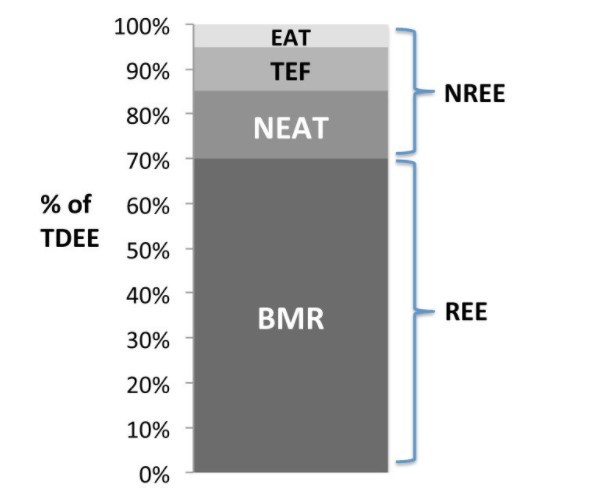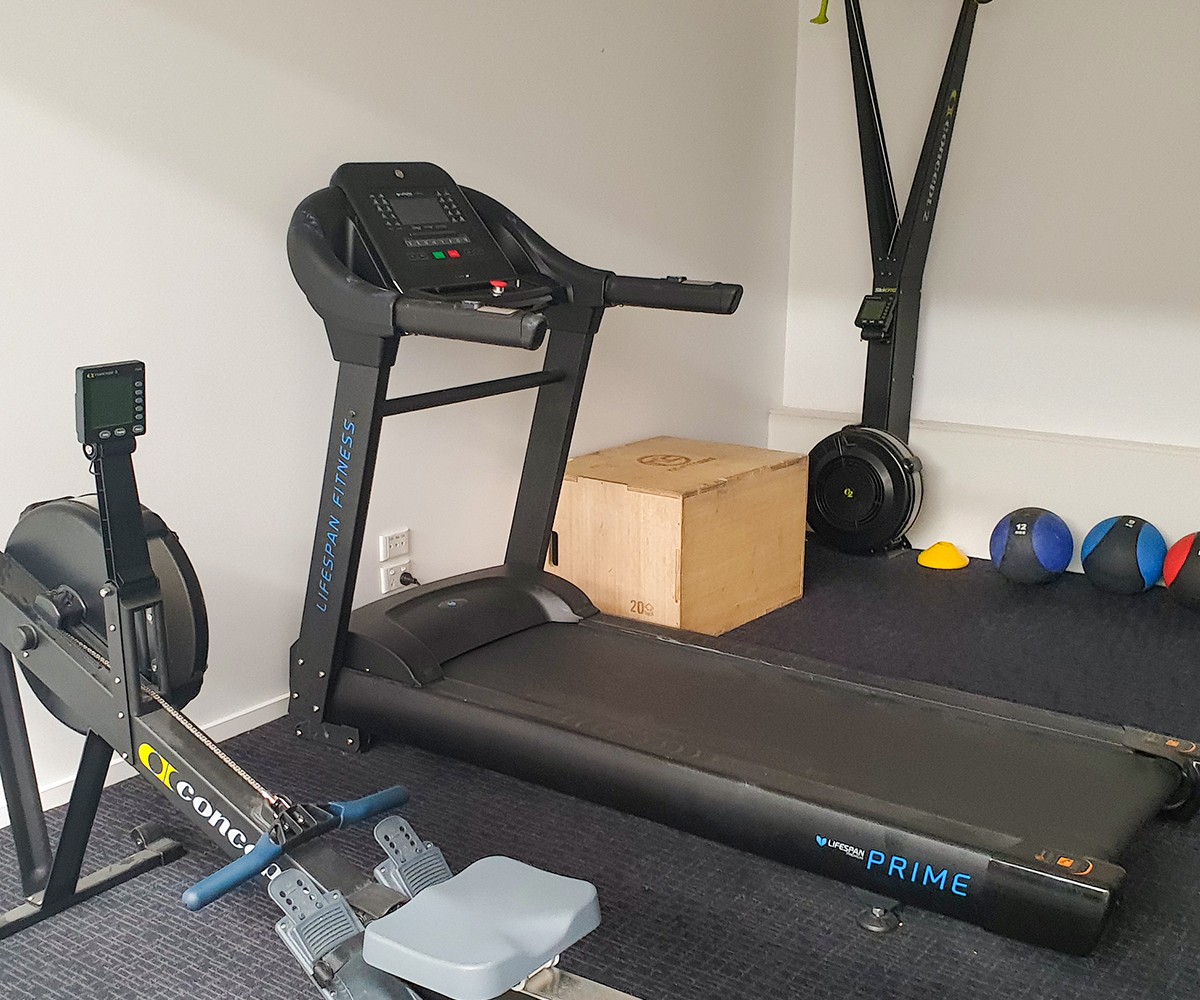How many Calories do we Actually Burn in the Gym?

How do we burn our calories daily?
Ask anyone inside a gym, and most will tell you the bulk of the calories we burn come from exercise.
But unless you're a marathon runner, or training for hours on end, this is likely to actually NOT be the case!
Let's start with the ways in which we burn calories daily as referred to by science:
BMR: Refers to basal metabolic rate. These are the calories burned by simply surviving. We're talking about breathing, cell production, circulation, etc.
NEAT: Refers to non-exercise activity thermogenesis. These are the activities that burn calories, that aren't actually "exercise" -- walking to the bathroom, maintaining posture, tapping your fingers on the desk unintentionally, etc.
TEF: This is the thermic effect of food. When we eat food, our body must produce heat in order to digest it which costs calories. For protein, this is the highest; 30% of the calories from protein are lost in the digestion process alone. Take a look:
EAT: Refers to exercise activity thermogenesis. Despite the misleading name, EAT has nothing todo with consuming food! It's the calories we burn exercising.
So where do we burn most of our calories from?
***Drum roll please***
From NEAT!
The simple actions of walking to the bathroom, tapping our feet, etc, burn more calories generally than the exercise we do. Take a look at the graph below:

Graph adapted from Maclean et al., 2011 (You'll notice "NREE" and "REE" on the table. NEAT, TEF and EAT all come under the category of "NREE", which refers to non-resting energy expenditure because of course, we're moving when we're burning these calories. BMR, our body simply surviving, comes under the heading of "REE", referring to "resting energy expenditure.")
This is enlightening information for many. Now of course this doesn't apply to the athlete training hours a day, it's more for the everyday person who spends their days sitting at a desk and carves out time in the day to exercise.
The graph above shows how we burn ~5% of our calories from exercise. Now, this won't be exact for all of us, but it's a solid yardstick.

So, for Bulk Nutrients customer "Pheobe", who might have a total daily energy expenditure (TDEE) of 2400 calories; 5% of this is 120 calories. This is compared to NEAT which in this context, would be 360 calories.
NEAT for fat loss
Let's take a deeper look at NEAT, which also includes other activities like:
- Walking to your next meeting
- Taking the stairs when you can
- Standing at a desk instead of sitting
- Grocery shopping
- Cleaning your living space
- Playing with your kids
- Gardening
- Walking your dog
- Chewing gum
So, if we pay special attention to these activities and prioritise them where possible, it might be a better long term daily solution to exercise for weight loss.
And we want to focus on the third point above there -- standing instead of sitting.
If you can get yourself a standing desk, you might be able to burn an extra 100 calories plus an hour.
Add that up over an 8-hour workday, and that's 800+ extra calories a day!
For example, Bulk Nutrients customer Pheobe is 77 kilograms and stands for 4 hours. According to the research in line with the "compendium of physical activities," she'll burn an average of 134 calories per hour.
That's 536 calories after 4 hours, and 1072 calories at the end of an 8-hour workday!
So, if you're struggling to fit exercise into your daily schedule, a standing desk might be helpful towards your fat loss goals. And you're likely to burn more calories doing it, too.
How many calories do we burn exercising?
To put the calories burned from NEAT into perspective, let's take a look at the research into various types of training, and the calories burned in a 30-minute bout of exercise:
A resistance training session at 75% of their 1-repetition maximum: ~8.83 calories per minute (30 minutes = ~265 calories burnt).
An endurance cycling session at 70% maximum heart rate: ~9.23 calories per minute (30 minutes = ~277 calories burnt).
An endurance treadmill session at 70% maximum heart rate: ~9.48 calories per minute (30 minutes = ~284 calories burnt).
A high-intensity interval training (HIIT) session on a resistance machine, that included repeating intervals of 20 seconds at a maximum effort followed by 40 seconds of rest: ~12.62 calories per minute (30 minutes = ~379 calories burnt).

Now given NEAT burns about 360 calories as outlined above, this is eye-opening.
The point is we don't burn as many calories in the gym as we think, and we actually are likely to burn more every day via NEAT.
The bottom line is that by focusing on NEAT; taking the stairs, standing at our desks daily, or even walking from one place to the next more often, we're likely to burn more calories than going to the gym or exercising elsewhere.
Of course, going to the gym provides other benefits more than simply calories burned, but for someone looking to maximise calories burnt for fat loss, this information should be of use. Focusing on NEAT in conjunction with gym training is likely to deliver substantial fat loss results.

Dayne Hudson
Like many, Dayne was once desperate to lose weight and get into shape. But everyone he asked, everything he read, lead to the same place... nowhere.
His journey started there - researching science journals and completing a Sports Nutrition Specialist qualification so he could make weight loss easier.
References:
- Ainsworth BE, Haskell WL, Herrmann SD, Meckes N, Bassett DR Jr, Tudor-Locke C, Greer JL, Vezina J, Whitt-Glover MC, Leon AS. 2011 Compendium of Physical Activities: a second update of codes and MET values. Med Sci Sports Exerc. 2011 Aug;43(8):1575-81. doi: 10.1249/MSS.0b013e31821ece12. PMID: 21681120.
- Chung N, Park MY, Kim J, Park HY, Hwang H, Lee CH, Han JS, So J, Park J, Lim K. Non-exercise activity thermogenesis (NEAT): a component of total daily energy expenditure. J Exerc Nutrition Biochem. 2018 Jun 30;22(2):23-30. doi: 10.20463/jenb.2018.0013. PMID: 30149423; PMCID: PMC6058072.
- Falcone PH, Tai CY, Carson LR, Joy JM, Mosman MM, McCann TR, Crona KP, Kim MP, Moon JR. Caloric expenditure of aerobic, resistance, or combined high-intensity interval training using a hydraulic resistance system in healthy men. J Strength Cond Res. 2015 Mar;29(3):779-85. doi: 10.1519/JSC.0000000000000661. PMID: 25162652.
- Maclean PS, Bergouignan A, Cornier MA, Jackman MR. Biology's response to dieting: the impetus for weight regain. Am J Physiol Regul Integr Comp Physiol. 2011 Sep;301(3):R581-600. doi: 10.1152/ajpregu.00755.2010. Epub 2011 Jun 15. PMID: 21677272; PMCID: PMC3174765.
- Sabounchi NS, Rahmandad H, Ammerman A. Best-fitting prediction equations for basal metabolic rate: informing obesity interventions in diverse populations. Int J Obes (Lond). 2013;37(10):1364-1370. doi:10.1038/ijo.2012.218




























